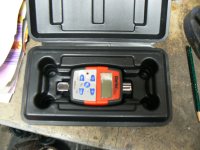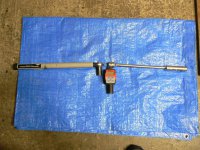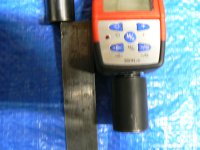Good, the first half of this thread was accepted. So now onto my newer "gear".
Having had what I believe to be a success with playing off one torque wrench against another to check calibration (ok, not that accurate I'm sure) I'd been talking about it to another mechanic friend who showed me his very expensive Snap On digital torque wrench. Wow, what a tool - and Wow what a price! We got to wondering if it could be used in the same as I'd done with the Norbar and Britool but maybe with more accuracy? Anyway, it made for an interesting conversation if nothing else. Then, some time later, I became aware of digital torque adaptors and spotted that Machine Mart sell a version of a popular one, you see often on the internet, under their Clarke brand name.


I spent quite some time and effort researching this and it all looked pretty good. It's not all that expensive, but not exactly bargain basement either. However it has a huge range 70 to 340 nm (50 to 250 lbs/ft) so would cover pretty much anything I was likely to come across except the smaller fixings, but I have the Norbar, the Britool and a Halfords (Norbar I think) three eighths drive which covers those (8 to 60 nm 6 to 44 lbs/ft). With conventional wrenches being only truly accurate around their mid range I was concerned about linear accuracy so I rang the Clarke people direct and had a very informative chat with a very well informed rep. Being electronic - I presume it works via a strain guage?, forgot to ask, Doh! - it uses no mechanical parts - like springs and levers with pivots - so is much more accurate over it's full scale deflection, Again, having no mechanical parts it needs no periodic return for specialist calibration. It does have a calibration procedure, which you carry out before use, to better align it to available battery capacity as the batteries, two CR 2032 button cells, age and it tells you when new batteries are needed. I bought one - I'm still using the batteries that came with it!
I really like this tool but it does have one great drawback. By the time you've got it assembled with a bar of some sort on one side and a socket on the other, Man, it's so deep you can't really use it in confined spaces. So working on stuff like cam belt tensioners etc, where you are in between the inner wing and the front of the engine is pretty much impossible. I mean, you are talking inches, see here:


No problem on stuff like head bolts and lots of other stuff though.
One thing I really do like it for is checking my other wrenches for accuracy. Here it is plugged into an old O2 sensor socket in my vice and the Britool on top:

Set the scale to "ranging" and as you pull on the wrench the scale displays the rising value. just watch for waht it's showing when the wrench clicks. repeat a few times for accuracy. Of course, if you are using it for actually torquing a fixing, I prefer to have it set to the required figure and listen for the audible warning as that figure is achieved.
So now, the big old Britool is simply an impressive ornament on my tool board. The smaller Britool I bought all those years ago spends most of it's life resting in my tool chest, ready for duty "just in case". So these are the "friends" I use all the time:

Both have ratchet action which I strongly recommend. The angle guage is an absolute must these days and the digital adaptor is used where possible for tightening fixings, because I reason it's likely to be more accurate then the mechanical wrenches, but also for periodically doing an approximate check on the accuracy of the mechanical wrenches.
So there you are folks. Hope you all enjoyed that? Feel free to ask questions, I might even be able to make an intelligent answer!
Having had what I believe to be a success with playing off one torque wrench against another to check calibration (ok, not that accurate I'm sure) I'd been talking about it to another mechanic friend who showed me his very expensive Snap On digital torque wrench. Wow, what a tool - and Wow what a price! We got to wondering if it could be used in the same as I'd done with the Norbar and Britool but maybe with more accuracy? Anyway, it made for an interesting conversation if nothing else. Then, some time later, I became aware of digital torque adaptors and spotted that Machine Mart sell a version of a popular one, you see often on the internet, under their Clarke brand name.

I spent quite some time and effort researching this and it all looked pretty good. It's not all that expensive, but not exactly bargain basement either. However it has a huge range 70 to 340 nm (50 to 250 lbs/ft) so would cover pretty much anything I was likely to come across except the smaller fixings, but I have the Norbar, the Britool and a Halfords (Norbar I think) three eighths drive which covers those (8 to 60 nm 6 to 44 lbs/ft). With conventional wrenches being only truly accurate around their mid range I was concerned about linear accuracy so I rang the Clarke people direct and had a very informative chat with a very well informed rep. Being electronic - I presume it works via a strain guage?, forgot to ask, Doh! - it uses no mechanical parts - like springs and levers with pivots - so is much more accurate over it's full scale deflection, Again, having no mechanical parts it needs no periodic return for specialist calibration. It does have a calibration procedure, which you carry out before use, to better align it to available battery capacity as the batteries, two CR 2032 button cells, age and it tells you when new batteries are needed. I bought one - I'm still using the batteries that came with it!
I really like this tool but it does have one great drawback. By the time you've got it assembled with a bar of some sort on one side and a socket on the other, Man, it's so deep you can't really use it in confined spaces. So working on stuff like cam belt tensioners etc, where you are in between the inner wing and the front of the engine is pretty much impossible. I mean, you are talking inches, see here:


No problem on stuff like head bolts and lots of other stuff though.
One thing I really do like it for is checking my other wrenches for accuracy. Here it is plugged into an old O2 sensor socket in my vice and the Britool on top:

Set the scale to "ranging" and as you pull on the wrench the scale displays the rising value. just watch for waht it's showing when the wrench clicks. repeat a few times for accuracy. Of course, if you are using it for actually torquing a fixing, I prefer to have it set to the required figure and listen for the audible warning as that figure is achieved.
So now, the big old Britool is simply an impressive ornament on my tool board. The smaller Britool I bought all those years ago spends most of it's life resting in my tool chest, ready for duty "just in case". So these are the "friends" I use all the time:
Both have ratchet action which I strongly recommend. The angle guage is an absolute must these days and the digital adaptor is used where possible for tightening fixings, because I reason it's likely to be more accurate then the mechanical wrenches, but also for periodically doing an approximate check on the accuracy of the mechanical wrenches.
So there you are folks. Hope you all enjoyed that? Feel free to ask questions, I might even be able to make an intelligent answer!

